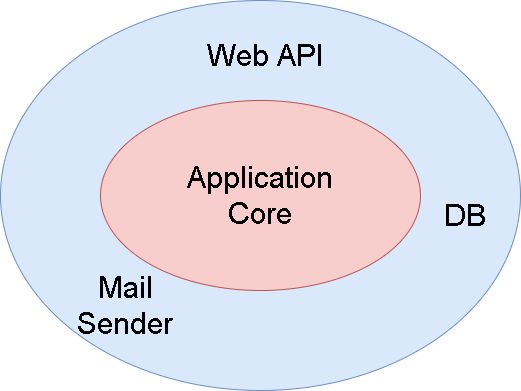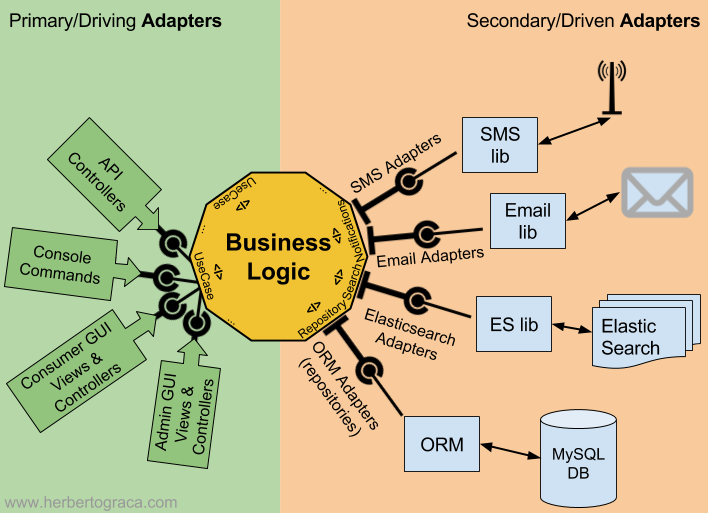Ports and adapters architecture. Nameko microexample
[software-architecture port-and-adapters hexagonal-architecture python nameko Introduction
Port and adapters (or hexagonal) architecture is a software design concept introduced by Alistair Cockburn in 2005. The main goal of it is to provide a clear separation between application logic and external dependencies like database, user interface, a framework providing HTTP requests, etc.

Application core, which is agnostic about external services and dependencies, should provide orchestration of the whole business process exploiting existing ports. There are two types of ports:
- primary port, is an entry exposing the application core to the outside world. It is usually a facade called by a primary adapter (e.g. REST API, CLI, etc.),
- secondary port, enables the application core to communicate with the external world (e.g. database, mail sender, etc). It is an interface that is implemented by a secondary adapter.

Implementation
Nameko is a python framework for building microservices providing simple HTTP requests, RPC, and Messaging over AMQP protocol. In our simple example, we implement an application that registers entries to the system and emits an event that should be handled in other parts of the system (or other microservice).
We define a secondary port as an interface that enables publishing domain events from the application core. Depending on implementation it could publish messages to a local event bus or genuine event broker like RabbitMQ (but implementation is a responsibility of an adapter).
from abc import ABC, abstractmethod
class EventPublisher(ABC):
@abstractmethod
def publish(self, events):
pass
To implement secondary adapter for EventPublisher we make a wrapper for Nameko EventDispatcher class.
# domain/events.py
from datetime import datetime
from typing import Dict
from dataclasses import dataclass
@dataclass(frozen=True)
class DomainEvent:
@property
def as_dict(self) -> Dict:
serialized = asdict(self)
serialized["name"] = self.name
return serialized
@dataclass(frozen=True)
class RegisteredEntryEvent(DomainEvent):
email: str
name: str = 'RegisteredEntryEvent'
timestamp: datetime = datetime.now()
# infrastructure/event_publisher.py
from typing import List
from nameko.events import EventDispatcher
from application.event_publisher import EventPublisher
from domain.event import DomainEvent
class NamekoEventPublisher(EventPublisher):
def __init__(self, dispatcher: EventDispatcher):
self._dispatcher = dispatcher
def publish(self, events: List[DomainEvent]) -> None:
for event in events:
self._dispatcher(event.name, event.as_dict)
Primary port in our example is a simple application service defining registration use case. EventPublisher interface (not implementation) is injected into the service.
# application/service.py
from application.event_publisher import EventPublisher
from domain.event import RegisteredEntryEvent
class RegistrationService:
def __init__(self, event_publisher: EventPublisher):
self._event_publisher = event_publisher
def register_entry(self, email: str) -> None:
event = RegisteredEntryEvent(email=email)
# this should some business / domain stuff executed
self._event_publisher.publish(event)
Nameko HTTP endpoint is a primary adapter for our RegistrationEntryService port. It handles HTTP request data and executes the service method.
import json
from nameko.events import EventDispatcher
from nameko.web.handlers import http
from werkzeug.wrappers import Request, Response
class NamekoRegistrationService:
name = "nameko_registration_service"
dispatcher = EventDispatcher()
@http("POST", "/register")
def register_entry(self, request: Request) -> Response:
request_params = json.loads(request.data)
email = request_params["email"]
service = RegistrationService(
event_dispatcher=NamekoEventPublisher(self.dispatcher),
)
service.register_entry(email)
return Response(f"Registered entry for {email=}")
The crucial thing here is that our application core does not have any knowledge about infrastructure and API, it operates only on interfaces. If we need database access, we should define a repository interface and inject it into our service. Or, if there is a need for notification sending, we should make a notification sender interface that can be implemented by SMS or Email sender adapter in the infrastructure layer. But inside the application core, we know nothing about infrastructure implementations (thanks to it the application logic can be easily unit tested). And this is the main gain of using this architecture.
Summary
It was a micro example of hexagonal architecture base concepts using Python and Nameko. If you find it interesting, I recommend you to visit my Github repository for extended implementation (including also a domain layer that was omitted here, for the sake of simplicity) of a similar project (also Python, Nameko, and Port and Adapters): https://github.com/jorzel/opentable. For more theoretical background about hexagonal architecture, go here.